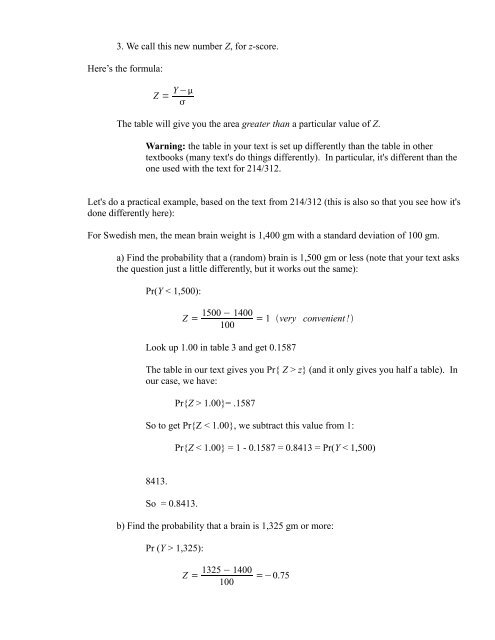n ypy
n ypy
n ypy
Create successful ePaper yourself
Turn your PDF publications into a flip-book with our unique Google optimized e-Paper software.
3. We call this new number Z, for z-score.<br />
Here’s the formula:<br />
Z = Y −<br />
<br />
The table will give you the area greater than a particular value of Z.<br />
Warning: the table in your text is set up differently than the table in other<br />
textbooks (many text's do things differently). In particular, it's different than the<br />
one used with the text for 214/312.<br />
Let's do a practical example, based on the text from 214/312 (this is also so that you see how it's<br />
done differently here):<br />
For Swedish men, the mean brain weight is 1,400 gm with a standard deviation of 100 gm.<br />
a) Find the probability that a (random) brain is 1,500 gm or less (note that your text asks<br />
the question just a little differently, but it works out the same):<br />
Pr(Y < 1,500):<br />
Z =<br />
1500 − 1400<br />
100<br />
Look up 1.00 in table 3 and get 0.1587<br />
= 1 very convenient!<br />
The table in our text gives you Pr{ Z > z} (and it only gives you half a table). In<br />
our case, we have:<br />
Pr{Z > 1.00}= .1587<br />
So to get Pr{Z < 1.00}, we subtract this value from 1:<br />
Pr{Z < 1.00} = 1 - 0.1587 = 0.8413 = Pr(Y < 1,500)<br />
8413.<br />
So = 0.8413.<br />
b) Find the probability that a brain is 1,325 gm or more:<br />
Pr (Y > 1,325):<br />
Z =<br />
1325 − 1400<br />
100<br />
=−0.75
















